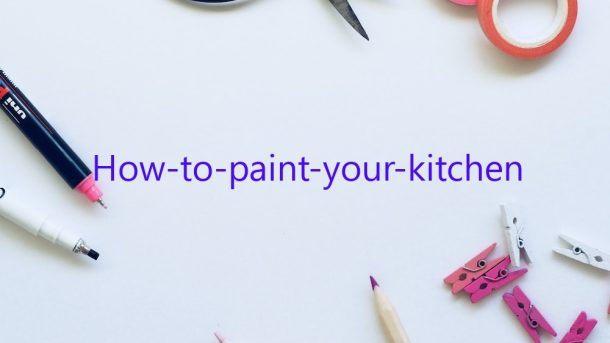How to Paint your Kitchen
When it comes to painting your kitchen, the options can seem endless. So, where do you start? Here is a basic guide to help you get started on the painting process.
1. Choosing the right paint
The first step is to select the right paint for your kitchen. There are a few things you need to consider when making your selection.
-The paint should be durable and able to withstand the wear and tear of everyday use.
-It should also be easy to clean and resistant to spills and stains.
-In addition, it’s important to select a paint that will complement the design of your kitchen.
There are a variety of paints to choose from, so take your time and select the one that’s best suited for your needs.
2. Preparing the surface
Before you begin painting, it’s important to prepare the surface. This involves cleaning and sanding the area to be painted.
-Clean the surface thoroughly with a household cleaner.
-Then, use a sandpaper to sand down any rough patches or areas that need to be smoothed out.
Make sure to remove all the dust and debris before moving on to the next step.
3. Painting the surface
Now it’s time to start painting! Begin by painting the edges of the surface with a brush. Then, use a roller to apply the paint in a smooth, even layer.
Be sure to take your time and avoid any streaks or missed spots. Allow the paint to dry completely before moving on to the next step.
4. Finishing the project
Once the paint has dried, you’re ready to finish the project. This involves adding the final touches, such as trim and cabinet hardware.
Be sure to take your time and do a good job. You want your kitchen to look its best, and a well-painted kitchen is sure to impress.
Contents [hide]
In what order do you paint a kitchen?
When it comes to painting a kitchen, there are a few things to keep in mind. The order in which you paint the kitchen will depend on the type of paint you are using, the surfaces you are painting, and the prep work that needs to be done.
If you are using a latex paint, you will usually want to start with the walls and then move on to the cabinets and trim. If you are using an oil-based paint, you will usually want to start with the trim and then move on to the walls and cabinets.
In either case, you will want to do the prep work before you start painting. This includes cleaning the surfaces, filling in any holes or cracks, and sanding down any rough patches.
Once the prep work is done, you can start painting. If you are painting the walls, you will want to start in one corner and work your way around the room. If you are painting the cabinets, you will want to start at the top and work your way down.
Once you have finished painting, you will want to let the paint dry completely before you start using the kitchen. This can take anywhere from several hours to several days, depending on the type of paint you are using.
How do you prepare a kitchen wall for painting?
There are a few steps you can take to prepare your kitchen wall for painting. You will need to clean the surface of the wall, remove any loose paint or wallpaper, and patch any holes or cracks. Once the surface is clean and smooth, you can then apply a primer to help the paint adhere to the wall. Finally, you can apply the paint in your desired color.
Do you need special paint for kitchen?
Many people might wonder if they need a special paint for their kitchen. The answer is that you don’t need a special paint, but there are some paints that might be better suited for a kitchen than others.
When painting a kitchen, you’ll want to use a paint that is durable and easy to clean. Paints that are specifically designed for kitchens are often more durable and easier to clean than other types of paint. However, you don’t have to use a paint that is specifically designed for kitchens. Any type of paint that is durable and easy to clean will work in a kitchen.
If you’re looking for a paint that is specifically designed for kitchens, there are a few options to choose from. Some paints are designed to resist moisture and humidity, which can be important in a kitchen. Other paints are designed to be easy to clean, with a finish that won’t show fingerprints or smudges.
If you’re not sure which paint is best for your kitchen, it’s always a good idea to consult with a professional. A professional can help you choose the right paint for your kitchen and give you tips on how to properly paint the room.
Can you paint kitchen without sanding?
Yes, you can paint kitchen cabinets without sanding, but the results may not be what you expect. The key is to use a good primer and plenty of it.
One option is to use a bonding primer. This is a type of primer that is designed to adhere to surfaces that are not perfectly smooth. It will help to create a surface that is smooth enough to allow the paint to adhere properly.
Another option is to use a primer designed for cabinets. This type of primer is specifically designed to create a smooth surface on cabinets. It will help to ensure that the paint adheres properly and that the finish is smooth.
In either case, you will need to apply the primer in several coats. It is important to allow each coat to dry completely before applying the next.
If you are not happy with the results, you may need to sand the cabinets before painting them.
Do you have to wash kitchen walls before painting?
When painting your kitchen walls, do you have to wash them before painting? The answer to this question is both yes and no. Yes, you should wash your kitchen walls before painting if they are dirty or covered in grease or food stains. However, if your kitchen walls are in good condition and do not need to be washed, you do not need to wash them before painting.
If your kitchen walls are dirty or covered in grease or food stains, you should wash them before painting in order to ensure a smooth, even paint job. Washing your walls will also help to get rid of any smells that may be lingering in the kitchen. However, if your kitchen walls are in good condition and do not need to be washed, you do not need to do so.
When painting your kitchen walls, it is important to use the right type of paint. Latex paint is a good option for kitchen walls, as it is easy to clean and does not require a lot of maintenance. In addition, latex paint is affordable and comes in a variety of colors.
If you are looking to update your kitchen walls, painting them with latex paint is a good option. Washing your walls before painting is essential if they are dirty or covered in grease or food stains, but if they are in good condition, you do not need to do so.
What is the most popular color for a kitchen?
There are a variety of colors that can be used for a kitchen, but the most popular color is white. kitchens with white cabinets and walls are bright and airy and can make a small space feel larger. White kitchens are also easy to decorate and can match any type of décor. However, some people may find white kitchens to be too bland and may want to use a different color for their kitchen.
Should kitchen walls be washed before painting?
Many homeowners choose to paint their kitchen walls a different color to give their kitchen a fresh look. There are many factors to consider before painting your kitchen walls, such as the type of paint to use and the preparation that is required. One factor you may not have considered is whether the walls need to be washed before painting.
The answer to this question depends on the condition of your kitchen walls. If your kitchen walls are in good condition and have no dirt or grease buildup, you do not need to wash them before painting. However, if your kitchen walls are dirty or have grease buildup, they need to be washed before painting. Washing your kitchen walls before painting will help the paint to adhere better and will result in a better-looking finished product.
If your kitchen walls are in good condition, you can wash them with a wet sponge and a mild detergent. If your kitchen walls are dirty or have grease buildup, you can wash them with a degreaser or a commercial kitchen cleaner. Be sure to rinse the walls thoroughly after washing them to remove all of the soap or cleaning solution.
Once the walls are clean, you can begin painting them. Be sure to follow the instructions on the paint can to ensure that you apply the paint correctly. Painting your kitchen walls is a great way to give your kitchen a fresh new look, but it is important to take the necessary steps to ensure that the paint will adhere to the walls properly. Washing your kitchen walls before painting is one of the steps that you can take to ensure a successful paint job.




